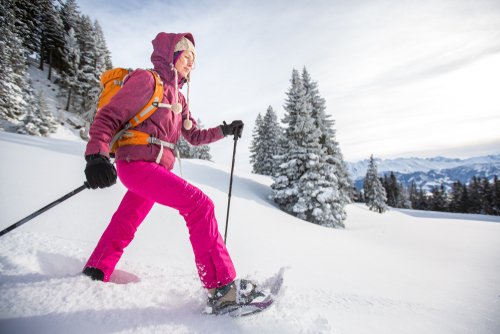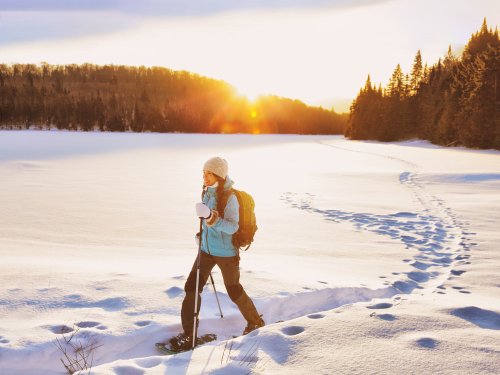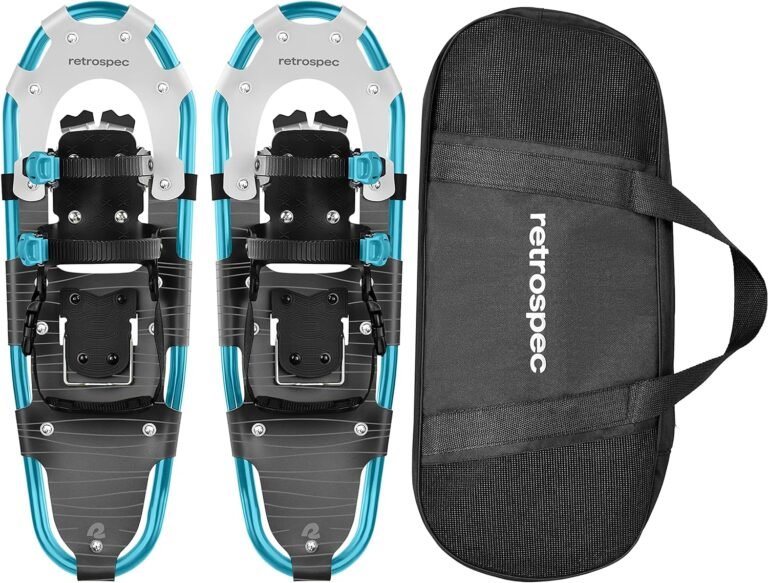Choosing the Best Snow Shoes – You Hare It Well!
When it comes to winter hunting and outdoor adventures, finding the best snow shoes can make a difference in enjoying the trek versus being too tired. But with so many options, how do you choose the perfect pair? Fear not, fellow adventurers; The Donkey has you covered.
First and foremost, consider the terrain you’ll be navigating. Different types of snow shoes are designed for specific terrains, so matching your footwear to the conditions you’ll encounter is essential.
If you plan on mostly traversing flat or rolling terrain, a recreational snow shoe will suit you just fine. These are typically lightweight and offer excellent maneuverability.
On the other hand, if your winter hunting plans involve tackling more challenging landscapes like steep hills or rugged mountainsides, opting for a backcountry snow shoe is highly recommended.
These models sport aggressive crampons underneath their frames, providing superior traction on slippery slopes. They also tend to have larger surface areas to help distribute your weight more efficiently.
Size matters when it comes to snow shoes, too! Consider both your body weight and pack weight when selecting a size.
The heavier you are or if you carry a substantial load on your adventure (like camping equipment), the longer and wider your snow shoes should be. Larger sizes prevent sinking into deep powder by increasing surface area contact with the snow.
Weight is another crucial factor in choosing suitable snowshoes. Lightweight models are ideal for those who want to move quickly and effortlessly through snowy landscapes.
However, remember that extremely light options may lack durability if you plan on tackling rough terrain regularly. Remember, fellow winter wanderer: finding the right pair of snowshoes involves considering various factors such as terrain type, size requirements based on weight distribution needs, and a balance between optimal weight and durability.
By doing thorough research and trying different pairs before committing to a purchase, you’ll set yourself up for a successful snowshoeing adventure ahead. So, get ready to embark on your winter hunting journey with the perfect pair of snow shoes on your feet!

Types of Snow Shoes for Different Terrains
When it comes to snowshoeing, choosing the right type of snowshoes can make all the difference in your winter trekking adventures. Different terrains call for different snowshoes, so it’s important to understand which ones best suit your intended outdoor activities.
For flat and packed trails, recreational snowshoes are your go-to option. These types of snowshoes are designed with ease and comfort in mind.
They typically have a lightweight frame and a smaller surface area, making them perfect for beginners or those looking for a more leisurely snow hiking experience. Recreational snowshoes are also ideal for gentle slopes or well-maintained trails, providing stability and traction on even terrain.
Looking for More?
If you’re planning to venture into more challenging terrains such as steep hills or icy slopes, backcountry snowshoes are what you need. These rugged and sturdy snowshoes have aggressive crampons underneath, providing superior grip on slippery surfaces.
They often come equipped with heel lifters, which also help reduce fatigue when tackling uphill climbs during your winter hiking adventures. For those seeking off-trail adventures through deep powder or heavily wooded areas, consider investing in mountaineering snowshoes.
These snowshoes are designed with larger frames and wider surface areas, providing maximum flotation in soft, deep snow. The aggressive crampons on mountaineering models ensure excellent traction while maneuvering through uneven terrain or icy patches.
Wanna Race?
Specialized running or racing snowshoes are available for those who want to take their winter trekking experiences up a notch. These lightweight models feature minimalist designs with smaller frames and bindings, allowing quick movements on packed trails or compacted surfaces.
Ideal for fitness enthusiasts or competitive individuals wanting to test their limits in winter sports. Selecting the right type of snow shoes is essential when embarking on snowy adventures across different terrains.
Whether you prefer leisurely snow hiking on flat trails, conquering steep hills, exploring off-trail areas, or even participating in winter racing events, snowshoes are available to suit your specific needs. Understanding the various types of snowshoes and their suitability for different terrains will ensure a safe and enjoyable outdoor adventure throughout the winter season.
Snow Shoes: Size and Weight Considerations
When it comes to snowshoeing, size does matter. Choosing the right size of snow shoes is crucial for a comfortable and enjoyable winter trekking experience.
The size of your snow shoes depends on your body weight and the type of terrain you’ll be exploring. Smaller snow shoes will do the trick if you’re a beginner or planning to hike on packed trails or gentle slopes.
They are lighter and more maneuverable, perfect for casual outdoor adventures. On the other hand, if you’re an experienced adventurer seeking to conquer deep powder or steep terrains, larger snow shoes with more surface area offer better flotation and stability.
Weight is another important factor to consider when selecting snow shoes. The weight of the shoes directly affects your energy expenditure during snowshoeing.
Lighter models are ideal for longer treks and expeditions where you need to conserve energy. They also come in handy when navigating through challenging terrains that require quick movements.
However, it’s essential not to sacrifice durability for weight reduction if you plan on frequent winter hiking or trekking adventures in demanding conditions. When choosing your snow shoes, look for a balance between lightweight design and sturdy construction.
Remember that different brands may have varying recommendations regarding sizing based on weight ranges, so it’s always a good idea to check manufacturer guidelines before purchasing. Remember that finding the right balance between size and weight will greatly enhance your comfort and efficiency on snowy trails.
The Best Materials for Snow Shoes
When it comes to snowshoes, the materials they are made from are crucial for their performance and durability in various snowy terrains. To make an informed decision, it’s important to understand the different materials used in snowshoe construction.
Aluminum
One common material used for snow shoes is aluminum. Aluminum frames are lightweight yet sturdy, ideal for longer treks and challenging terrains.
They offer excellent support and stability while keeping the overall weight of the snowshoes down. Aluminum also has a natural resistance to corrosion, which is especially important when dealing with wet and snowy conditions.
Composite
Another popular choice for snowshoe frames is composite materials. These typically consist of a combination of plastics and carbon fiber or fiberglass.
Snowshoes made from composites are lightweight, durable, and provide good flotation on soft snow. They are also more flexible than aluminum, allowing for a more natural stride when traversing uneven terrains.
Decking Material
For the decking material – that’s the part you step on – synthetic fabrics like nylon or polyester are often used. These materials are lightweight, quick-drying, and resistant to moisture absorption.
They provide good traction on packed snow and deep powder while preventing excessive build-up of ice or snow. Regarding bindings, which secure your boots onto the snow shoes, manufacturers commonly use materials like neoprene or rubberized straps with adjustable buckles.
Neoprene offers flexibility even in cold temperatures while providing a snug fit around your boots. Rubberized straps ensure a secure hold without compromising comfort.
And bindings made from neoprene or rubberized straps give you a secure and comfortable fit. So, consider these material choices before embarking on your snowshoeing adventure to make the most of your outdoor winter escapades!
Snowshoeing Accessories and Gear
Having the right accessories and gear can make all the difference in enhancing your outdoor adventure. Here are some essential items you should consider:
1. Trekking Poles
These handy tools provide stability and balance while trekking through various terrains. Look for lightweight poles with adjustable lengths to suit your height and preferences. They’ll help take some of the strain off your legs, especially when tackling steep slopes or deep snow.
2. Gaiters
Gaiters are a must-have for winter trekking as they keep snow from entering your boots and pants. They act as a barrier, preventing moisture from seeping in and keeping you dry throughout your adventure. Look for gaiters made from waterproof materials that offer good coverage.
3. Backpack
A well-designed backpack is essential for carrying all your necessities during a snowshoeing expedition. Choose a backpack with multiple compartments to organize your belongings efficiently. Ensure it has padded straps and back support for added comfort during long hikes.
4. Winter Boots
The right footwear is crucial for enjoying winter hiking to its fullest potential. Look for insulated boots with good traction to provide warmth and grip on icy or slippery surfaces. Waterproofing is also important to keep your feet dry in wet conditions or trudging through deep snow.
Additionally, there are several other items worth considering depending on the duration and intensity of your adventure, such as headlamps or flashlights if you plan on exploring during low-light conditions, extra layers of clothing like thermal base layers or fleece jackets for added warmth, and a first aid kit in case of any minor injuries along the way.
Remember, being prepared with the right accessories will enhance your comfort and ensure safety during your snowshoeing escapades in various terrains. So, gear up properly before embarking on your snowy journey!
Tips for First-Time Snowshoe Buyers
When embarking on your first snowshoeing adventure, there are a few important tips to remember before purchasing your very own pair of snowshoes. These handy tips will ensure that you make a well-informed decision and have an enjoyable experience out on the snowy trails.
First and foremost, it’s crucial to consider the terrain you’ll be venturing into. Different terrains require different types of snowshoes.
For instance, if you plan on tackling steep and icy slopes, investing in snowshoes with aggressive crampons will provide better stability and grip. On the other hand, if you are trekking through deep powder or fluffy snow, look for snowshoes with larger surface areas to prevent sinking.
Size and weight are also significant factors when selecting snowshoes. The shoe size is typically determined by your weight and the type of terrain you’ll encounter.
Heavier individuals or those carrying heavy backpacks will need larger shoes to distribute their weight more effectively. Additionally, lighter shoes can be advantageous for faster-paced winter hiking adventures.
Material choice is another aspect worth considering. Snowshoes can be made from aluminum, plastic, or composite materials like carbon fiber.
Each material has its pros and cons regarding durability, weight, and cost. Aluminum frames are known for their strength but can be heavier than other options.
Plastic frames offer affordability but may not hold up as well against rugged terrains. Don’t forget about accessories and gear that go hand-in-hand with snowshoeing!
Investing in suitable boots that provide insulation from cold temperatures while offering ankle support for stability on uneven surfaces is essential. Gaiters are also highly recommended, as they protect your legs from getting wet or filled with snow during winter trekking adventures.
Considering these helpful tips for first-time snowshoe buyers, you’ll be well-prepared for your snowy outdoor adventure. Remember to choose snowshoes appropriate for the terrain, consider size and weight, evaluate material options, and remember the essential accessories.
With the right equipment, you’ll be ready to explore the winter wonderland easily and confidently. So lace up those boots and get ready for an unforgettable snowshoeing experience!
Practical Advice for Snowshoeing in Varied Terrains
When it comes to snowshoeing, one of the most exciting aspects is the ability to explore a wide range of terrains. From picturesque snowy forests to steep mountain slopes, no shortage of adventure awaits you.
However, before embarking on your winter trekking journey, it’s important to keep a few practical tips in mind. First and foremost, always check the weather conditions and trail reports before heading out.
Different terrains can pose different challenges depending on recent snowfall or temperature fluctuations. Knowing what to expect will help you prepare adequately and ensure a safer outdoor adventure.
Additionally, familiarize yourself with the terrain you’ll be traversing. Consider factors such as elevation gain, trail difficulty, and hazards like icy patches or hidden obstacles.
Gear
Next, let’s talk gear! Having the right equipment is crucial when venturing into varied terrains during winter hiking excursions. Choose snowshoes with aggressive traction if you anticipate encountering steeper slopes or icy surfaces. These will provide better grip and stability on different types of terrain.
Also, consider investing in adjustable poles that can help with balance and provide additional support while navigating tricky sections. In addition to proper gear selection for snowshoeing in diverse terrains, understanding basic techniques can greatly enhance your experience.
When ascending steeper inclines, use shorter steps with more power from your legs—a “kicking step.” This will ensure your snowshoes dig into the snowpack effectively for improved traction. Conversely, when descending slopes or traversing flat terrain, longer strides combined with a slight rocking motion will help maintain momentum while conserving energy.

Be Prepared
But, importantly—always be prepared! Pack essential items such as extra layers of clothing appropriate for changing weather conditions, like waterproof outerwear and moisture-wicking base layers.
Carry enough food and water to nourish and hydrate throughout your snow hiking adventure. Don’t forget to bring a map, compass, or GPS device to stay on track and a headlamp or flashlight in case daylight fades before your return.
By following these practical tips for snowshoeing in varied terrains, you’ll be well-equipped to embark on an unforgettable winter adventure. Remember to prioritize safety and always respect the environment you’re exploring.
With the right gear, techniques, and preparation, you’ll fully enjoy the beauty of nature while mastering the art of snowshoeing across diverse landscapes. So lace up those snowshoes and prepare for an outdoor experience like no other!
How to Maximize Comfort and Efficiency in Snowshoes
There are a few key factors to consider to maximize comfort and efficiency in snowshoes. First and foremost, it’s essential to wear the right kind of socks.
Opt for moisture-wicking socks made from materials like merino wool or synthetic fibers. These keep your feet dry and warm during winter treks, preventing blisters and discomfort.
Another crucial aspect is ensuring a proper fit for your snowshoes. Before strapping them on, adjust the bindings to fit snugly around your boots.
You want them tight enough to provide stability but not so tight that they restrict blood flow or cause discomfort. Take a little time to experiment with different adjustments until you find the perfect fit for your feet.
When venturing out on winter hikes or snowshoeing adventures, it’s important to dress in layers. This allows you to regulate your body temperature as needed, especially when navigating varied terrains and encountering fluctuating weather conditions.
Start with a moisture-wicking base layer, add insulating mid-layers like fleece or down jackets, and top it off with a waterproof outer shell to protect against wind and snow. To enhance efficiency while snowshoeing, pay attention to your stride technique.
Instead of taking long strides on regular terrain, take shorter steps while keeping your feet parallel. This distributes weight evenly across the snowshoes’ surface area and prevents them from overlapping or tripping over each other—a common mistake beginners make.
Additionally, consider using trekking poles during your winter hikes or snowshoeing excursions. These poles provide extra stability on uneven ground and help engage the upper body muscles for more efficient movement.
Adjust the length of the poles so that they allow for a slight bend in your elbows when holding onto them. By following these tips, you’ll be well on your way to maximizing comfort and efficiency during any outdoor adventure involving snowshoes.
Remember: proper socks, a secure fit, layering clothing, mastering stride technique, and utilizing trekking poles are all essential elements to ensure an enjoyable and successful snow hiking experience. So grab your gear, head out into the winter wonderland, and embrace the exhilarating world of snowshoeing!

Conclusion: Choosing Snow Shoes That Last
After considering all the essential factors of choosing the right snow shoes, it’s clear that investing in a durable and high-quality pair is crucial. When looking for snow shoes that will last through many winter adventures, there are a few key aspects to keep in mind. Firstly, pay attention to the materials used to construct the snow shoes.
Choose models that utilize sturdy and weather-resistant materials, such as aluminum frames and durable synthetic decking. These materials provide excellent durability and ensure that your snow shoes can withstand various terrains and weather conditions.
Secondly, consider the binding system of the snow shoes. Look for bindings that are adjustable, easy to use, and secure.
A good binding system will allow you to quickly adjust your snow shoes to fit different boot sizes while providing a snug and comfortable fit. This is particularly important when traversing steep or uneven terrain during winter treks.
Additionally, take note of any additional features or technologies incorporated into the design of the snow shoes. Some models have crampons or traction bars strategically placed on their frames to enhance grip on icy or slippery surfaces.
These features can significantly improve stability and prevent slips while hiking in snowy conditions. Remember that proper maintenance is crucial for ensuring longevity in your snow shoes.
After each use, clean off any dirt or debris from the bindings and frames. Store them in a cool and dry place away from direct sunlight to prevent damage from UV rays.
By selecting snow shoes made with durable materials, equipped with reliable binding systems, incorporating useful features like crampons or traction bars when necessary, coupled with regular maintenance practices – you’ll be setting yourself up for many successful adventures on snowy trails!
So embrace winter hiking confidently on your next outdoor adventure, knowing you’ve chosen reliable gear built to last through all kinds of winter wonderlands!







